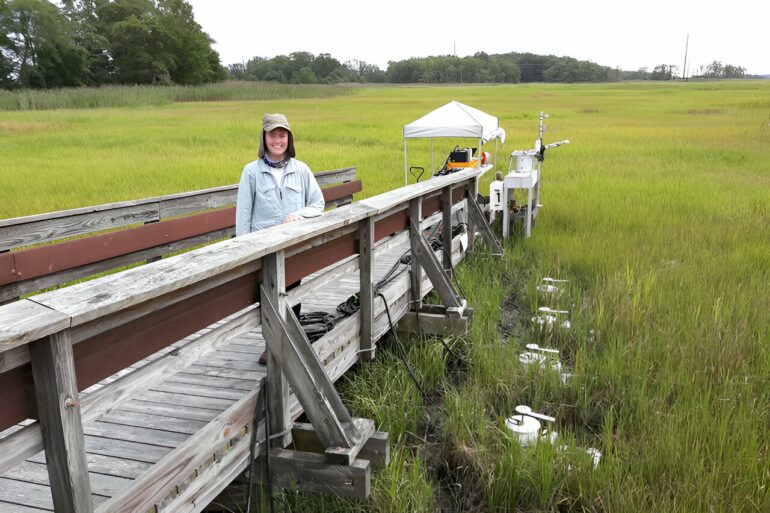Tidal salt marshes are fairly common across the Mid-Atlantic. These coastal ecosystems provide habitat for plants, birds and fish. Existing at the intersection of land and sea, tidal salt marshes act as armor against hurricanes and shoreline erosion.
Tidal salt marshes are also a powerful tool to combat climate change, said Rodrigo Vargas, an ecosystem ecology and environmental change professor in the Department of Plant and Soil Sciences at the University of Delaware. These ecosystems absorb the greenhouse gas carbon dioxide from the atmosphere, and their soils act as a carbon vault.
“These ecosystems are threatened across the world. They are disappearing because of different problems, such as land use change and sea level rise,” Vargas said. “But they store a lot of carbon. So there is a big concern about what will happen to salt marshes now under climate change and what is going to happen with the carbon stored in these ecosystems.”
If tidal salt marshes shrink or disappear because of climate change or how human activities have transformed natural landscapes, could all the carbon they have stored go back into the atmosphere and further contribute to the warming of the Earth? Vargas said this is an important question that scientists are working on.
Tidal salt marsh soils are great at storing carbon because they’re often flooded and have salty water. These conditions lower oxygen levels and make it difficult for most microorganisms to consume the carbon in the soil. However, some microorganisms called methyl-methanogens can eat some of the carbon in the soil and produce methane under these conditions. That’s a far more powerful greenhouse gas with the ability to heat up the Earth more intensely than carbon dioxide.
In some marshes, the amount of methane produced and emitted can offset the amount of carbon captured by the ecosystem in the growing season.
New research, published in Global Change Biology, explores where the methane produced in soils of tidal salt marshes goes. UD researchers took their project to the St. Jones Reserve, a tidal salt marsh near Dover that is part of Delaware National Estuarine Research Reserve that flows into the Delaware Bay.
There, they found very high amounts of methane in its tidal salt marsh soils. Surprisingly, they also found the methane there was young, meaning it doesn’t stay in the soils and therefore it moves away from the salt marsh.
The researchers found concentrations of methane in tidal salt marsh soils of up to 145,000 parts per million, creating a conundrum. That’s “unexpectedly high,” the researchers say, given that methane in the Earth’s atmosphere is measured at just 2 parts per million.
“It’s like a methane bomb,” Vargas said. “There is so much methane there when in theory it should not be there.”
Because tidal salt marshes have relatively high concentrations of salts called sulfates, it was long thought they wouldn’t produce much methane. Higher amounts of sulfate usually hinder the production of this greenhouse gas, said Margaret (Maggie) Capooci, a graduate of UD’s Water Science and Policy doctorate program and lead author of the paper.
“When we found that there were high amounts of methane in the soil despite there being high amounts of sulfate in the system, we thought something else was going on,” Capooci said. “There must be some other process occurring that’s allowing for the production of methane even in the presence of these sulfate reducers.”
Initially, the researchers thought the methane would be released from the tidal salt marsh soils and disperse up into the atmosphere, like a chimney blowing smoke. Then, they thought that microbes in the tidal salt marsh soils were eating methane, converting it into carbon dioxide through a process called oxidation, and those microbes would then “poop out” carbon dioxide, Vargas said. Instead, they have evidence that the methane is likely moving off to the sides, into tidal creeks, making them hotspots for methane.
Tidal creeks function as the vital arteries of a salt marsh, enabling the crucial exchange of materials between the marsh, adjacent rivers, and the open ocean. As water ebbs and flows, it not only facilitates the transport of nutrients and carbon, but also acts as a dynamic conveyor belt.
When methane is released from the marsh soils into these creeks, the creeks effectively become conduits or channels through which methane can escape to the atmosphere. Or the methane can be transported to nearby rivers and the coastal ocean. This process underscores the role of tidal creeks in regulating the movement of greenhouse gases, emphasizing their importance in both local and global environmental contexts.
The methane ‘has to go somewhere’
When it comes to scientific research, typically scientists have a clear question, hypothesis and method to study their hypothesis.
“I thought this was going to be super easy,” Vargas said. “We found that there was a lot of methane in the soil. We knew that not so much methane was being released to the atmosphere. Therefore, we thought that microbes were eating the methane and producing carbon dioxide. So we thought that the carbon dioxide should have a signature, information that it was coming from methane.”
But it didn’t work out that way.
It took a lot of trial and error from multiple research techniques to get results. At the St. Jones Reserve, they started by measuring how much methane the ecosystem was “breathing,” Vargas said. Then, they put buckets on top of the soil to measure how much methane was coming out. They measured how deep methane and carbon dioxide were produced in the tidal salt marsh soils.
They even analyzed the microbial communities as well as carbon atoms that have different numbers of neutrons (called isotopes) for gas and soil samples, to find out the origin of and how old the methane was.
Ultimately, the researchers found that there is a lot of methane in salt marsh soils. The methane is not more than 70 years old, young by scientific standards, meaning it doesn’t stay forever in the soils. It’s not being released from tidal salt marshes straight up into the atmosphere. And it’s not being eaten by microbes in the soil.
“Therefore, that methane has to go somewhere,” Vargas said. “And we propose the methane is going to the side, laterally into creeks.”
Accounting for methane emissions
Vargas said the study’s findings have important implications for accounting protocols of greenhouse gases.
“The current protocols for carbon dynamics, even the carbon accounting and carbon credits, do not require us to measure methane in tidal salt marshes, because methane should not be there,” Vargas said. “But by neglecting that, we are missing a huge amount of the accounting of the carbon because our study demonstrates that it is produced there.”
He relates it to a person having a bank account with U.S. dollars and euros, but only accounting for one currency.
“Imagine your bank account is leaking rapidly but you’re not accounting for expenses in another currency,” Vargas said. “By neglecting the methane, we’re neglecting an important compound that is a greenhouse gas.”
Further, he says international protocols for measuring climate change and carbon dynamics in wetlands, don’t recommend measuring wetlands and tidal salt marshes for methane. Why? “Because it should not be there,” Vargas said.
Going forward, Capooci said, there needs to be more research done on the microbes living in salt marsh soils.
“What’s living in the soil? What do they do? How active are they? What kind of ‘food’ is available for them to eat, and when?” Capooci said.
Vargas said he is interested in the future of tidal salt marshes and how they’ll fare in the face of climate change and sea level rise.
“If you have sea level rise, the breathing of that ecosystem is going to change,” Vargas said. “Therefore, being able to measure and predict its breathing is important to understanding the state of this ecosystem.”
More information:
Margaret Capooci et al, High methane concentrations in tidal salt marsh soils: Where does the methane go?, Global Change Biology (2023). DOI: 10.1111/gcb.17050
Provided by
University of Delaware
Citation:
High methane concentrations in tidal salt marsh soils: Researchers seek to discover where it goes (2024, February 20)



